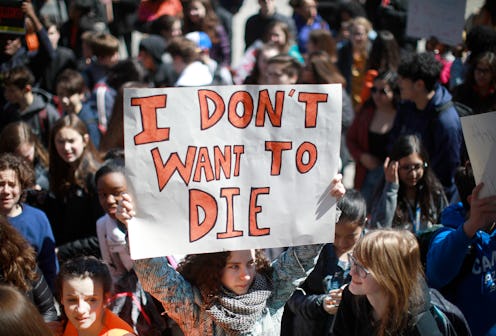News
11 Gun Violence Statistics That Will Devastate You

America has a gun violence epidemic. There's an average of one mass shooting per day in the United States, and a child dies from an accidental gunshot every 48 hours. Those are just two of the many alarming gun violence statistics that are worth keeping in mind on Gun Violence Awareness Day.
Although gun violence in America is nothing new, the topic has gradually received more and more attention over the last several years due to a steady stream of high-profile public shootings: Aurora and Sandy Hook in 2012, Fort Hood in 2014 (which is separate from the 2009 Fort Hood shooting), Charleston in 2015, Orlando in 2016 and many, many others. Gun violence hasn't abated since then: Two of the five deadliest mass shootings in U.S. history — the Las Vegas massacre and the shooting in Sutherland Springs — happened in 2017, while 2018 saw over 100 mass shootings in the United States by mid-May alone.
School gun violence has been a key component of this debate, in large part due to the fatal school shootings in Parkland, Florida, and Santa Fe, Texas, in 2018. Still, despite many calls to action, Congress has passed no major gun control legislation since any of the aforementioned shootings.
In honor of National Gun Violence Day, let's take a look at some of the most stark, sobering statistics about gun violence in America.
Homicides Per Year
According to Everytown Research, there are over 12,000 gun homicides in the United States every year on average. Moreover, CDC data shows that for every person killed by a gun, two more are injured.
Child Gun Deaths Since Columbine
Over 26,000 American kids have been killed by guns since the 1999 Columbine massacre, according to data from the Centers for Disease Control.
Women At Risk
Everytown Research also found that in the average month, 50 women are fatally shot by their romantic partners.
Racial Disparities
Gun violence in the United States is not equally distributed by race. Although black Americans only comprise 13 percent of the U.S. population, more than half of all gun homicide victims every year are black, according to the CDC. According to Everytown Research, black men are 13 times more likely to be shot to death in the United States than are non-hispanic white men.
More Dangerous Than The Military
Shortly after the Santa Fe shooting, a study at the Washington Post found that in 2018 so far, more people have been killed by guns at American schools than while deployed in the military.
Leading The World
America's gun violence is an international anomaly: According to Everytown Research, the gun homicide rate in the United States is more than 25 times higher than the average of other high-income countries. Furthermore, a study out of the University of Alabama found that although the United States only accounts for five percent of the world population, 31 percent of all public mass shootings take place in America.
Accidental Gunfire Killing Children
Intentional shootings aren't the only kind that kill: A 2016 study by the Associated Press and USA TODAY found that a child is killed in a gun accident every other day in the United States.
A Threat To Children
According to a study published in the journal Pediatrics, guns are now the third-leading cause of death for American children, behind illness and unintentional accidents like drownings.
Mass Shootings On The Daily
The Gun Violence Archive found in 2016 that there's an average of nearly one mass shooting in the United States every day.
Black Child Gun Deaths
When it comes to gun violence, black children are especially at risk: Pediatrics found that 56 percent of American children killed by guns are black.
School Shootings In 2018
As of Friday, there have been 23 school shootings in the United States in 2018, which averages out to more than once a week. That number actually understates things a bit, as it doesn't include school shootings in which nobody was hurt.
Although Congress has been remarkably stubborn in its refusal to pass gun control legislation, the staggering level of gun violence in America suggests that the debate over how best to reduce firearm deaths isn't going to die down any time soon.